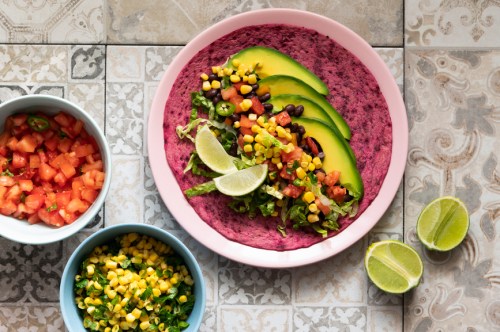According to a recent interview with Dan Buettner, a National Geographic reporter, longevity expert, and founder of the Blue Zones, there’s one thing all five of the healthy-aging hotspots around the world have in common: Deliciously flavorful food that’s been crafted with care.
Experts in This Article
Blue Zones expert and author of The Blue Zones Secrets for Longer Living
While each Blue Zone is highly diverse from the next (if you’re new to the term, these regions include Nicoya, Costa Rica; Ikaria, Greece; Sardinia, Italy; Okinawa, Japan; and Loma Linda, California), through research, Buettner has found that each of these communities emphasize taste—as opposed to focusing solely on nutritional value. And in addition to being delicious, Buettner’s also found that the majority of diets for longevity in the Blue Zones are heavily-reliant on plant-based ingredients.
That said, the concept of marrying the two—delicious flavors plus plants—hasn’t always been a Thing for many folks. (A shame, because plant-based meals are *chef’s kiss.*) To make plant-based eating as tasty as ever, we’ve gathered some of the best tips and tricks for boosting flavor no matter what you’re cooking.
5 tips for preparing flavorful food for longevity
1. Try incorporating new (and more) plants into your meals
It’s easy to fall into a rhythm of making the same five meals we know and love on repeat. (Hi, veggie lasagna.) However, some health experts argue that introducing new ingredients into your meal prep rotation can help promote a healthier and more diverse microbiome—a key factor for boosting longevity.
“When you expand the types of vegetables that are on your plate, you’re not just broadening your palate—you’re also increasing the biodiversity of nutrients that your body is exposed to. And according to gastroenterologists, the diversity of plants in your diet is the number one predictor of a healthy gut microbiome,” registered dietitian Maya Feller, MS, RD, CDN, previously shared with Well+Good. Some highly tasty and nutrient-dense options include fiber-rich veggies like artichokes, Brussels sprouts, and beets.
“When you expand the types of vegetables that are on your plate, you’re not just broadening your palate—you’re also increasing the biodiversity of nutrients that your body is exposed to.”—Maya Feller, MS, RD, CDN
2. Look to spices to add depth of flavor and anti-inflammatory benefits to dishes
While nothing can replace salt and pepper, there are seven spices that can add some extra oomph and dimension to any dish: cinnamon, turmeric, chili powder, cayenne powder, oregano, Chinese five-spice powder, and ginger. And when combined together, the possibilities are endless. Combinations like cinnamon, ground ginger, and a dash of Chinese five-spice powder can turn a bland bowl of oatmeal into a dish filled with complex layers of flavor.
It’s worth highlighting that while all of these spices are staples in the Blue Zones, turmeric, black pepper, ginger, and garlic but particularly prominent. These options are especially helpful if you’re looking to lower your sodium intake, as studies suggest that reducing salt consumption can have positive outcomes on overall health.
3. Adds herbs into the mix, too
Herbs are an easy way to add a one-two punch of flavor and nutrition to any meal. This is because many herbs have anti-microbial and antioxidant properties linked to boosting heart health, immunity, and digestion.
In the Blue Zones, folks tend to rely on a few common herbs, including fennel, oregano, rosemary, cilantro, and garlic. Thankfully, many of these herbs are available in most areas of the world. For ways to include some of these flavors, check out these five easy sauce recipes that will definitely dial up the flavor factor of your meals.
4. Roast veggies to bring out even more flavor
It’s no secret that roasted sweet potatoes tend to taste even better than, say, boiled ones. This is thanks to the Maillard reaction, a chemical reaction between amino acids (like protein) and reducing sugars that results in browned color and that classic rich, caramelized taste. (Think seared steak, roasted-until-golden potatoes, and crisp chocolate chip cookies.)
The key to nailing this technique? Ensuring you have the correct temperatures down. In the case of roasting veggies, you’ll want to prep your oven so it’s nice and hot, as well as the surface of the sheet pan you intend to use. This helps achieve the perfect amount of caramelization on the outside of your food while locking in the texture and moisture on the inside.
5. Rely on seasonal ingredients whenever possible
Ever wonder why vegan food at a restaurant always seems to taste just a wee bit better than what you make at home? Well, according to David Lee, the co-founder and executive chef of plant-based restaurant PLANTA, this shouldn’t be the case if you focus on a few things… starting with using seasonal ingredients whenever possible. What’s more, “Fruits and vegetables tend to be the most nutrient-dense right after they’re harvested when they’re at that peak ripeness, which is part of why seasonal produce tastes better,” Sara Riehm, RD, a registered dietitian at Orlando Health, previously shared with Well+Good.
“Fruits and vegetables tend to be the most nutrient-dense right after they’re harvested when they’re at that peak ripeness, which is part of why seasonal produce tastes better.”—Sara Riehm, RD
That’s why chefs recommend visiting specialty grocers and farmer’s markets to find the most unique seasonal and local ingredients to cook with.
An herbalist shares common and accessible herbs for stress and anxiety:
Sign Up for Our Daily Newsletter
Get all the latest in wellness, trends, food, fitness, beauty, and more delivered right to your inbox.
Got it, you've been added to our email list.











